- Acne
- Actinic Keratosis
- Aesthetics
- Alopecia
- Atopic Dermatitis
- Buy-and-Bill
- COVID-19
- Case-Based Roundtable
- Chronic Hand Eczema
- Chronic Spontaneous Urticaria
- Drug Watch
- Eczema
- General Dermatology
- Hidradenitis Suppurativa
- Melasma
- NP and PA
- Pediatric Dermatology
- Pigmentary Disorders
- Practice Management
- Precision Medicine and Biologics
- Prurigo Nodularis
- Psoriasis
- Psoriatic Arthritis
- Rare Disease
- Rosacea
- Skin Cancer
- Vitiligo
- Wound Care
Article
Promising new treatments for plaque psoriasis
The American College of Rheumatology annual meeting wrapped this month in San Diego. Results from long-awaited safety trials show promising new treatments.
INTRODUCTION

(FreeBirdPhotos/Shutterstock.com)
New evidence about the long-term safety of a treatment for plaque psoriasis and the safety of switching between biologic and biosimilar treatments, were among the studies presented this month at the American College of Rheumatology annual meeting in San Diego. Researchers also addressed a much talked about report from earlier this year in which investigators provided evidence for an increased risk of cardiovascular events in plaque psoriasis patients. In this slideshow, we summarize the findings from this report.

Secukinumab maintains long-term safety

(Pictured here on the left, untreated plaque psoriasis. On the right, plaque psoriasis at 24 weeks with secukinumab treatment. Photos courtesy of Dr. Philip Mease, M.D.)
Researchers report a favorable safety profile with long-term use of secukinumab to treat moderate-to-severe plaque psoriasis or psoriatic arthritis, according to data1 presented at the American College of Rheumatology annual meeting Nov. 13 in San Diego.
The new data, which updates and pools results from previous research2,3, suggests that the monoclonal antibody is safe with up to five years of exposure - with exposure in the psoriasis trials being the longest, according to the study’s lead author Philip J. Mease, M.D., of the University of Washington School of Medicine and chief of the Swedish Hospital Rheumatology Clinical Research Division, Seattle.
“It is always important to report on long-term safety in relation to an immunotherapy, since we have to be able to assure patients, colleagues, regulators, payors, etc., that we are not seeing new concerning signals,” Dr. Mease said. “[These concerns include] the realms of infection and cancer, or, as in the case of anti-tumor necrosis factor medications, rare paradoxical autoimmune reactions occurring, such as lupus, multiple sclerosis and psoriasis.”
Secukinumab data are reassuring, Dr. Mease said. “As with any immunomodulatory medicine, there is a small risk for serious infection. We have not seen a signal for tuberculosis or deep fungal infections such as Coccidioidomycosis or Histoplasmosis,” he said.
to the role that IL- 17 plays in protecting against Candida. Those infections are typically treated with standard topical or oral agents.
“We do not see a signal for any specific type of malignancy or major adverse cardiac events,” Dr. Mease said. “There were a small number of cases of suicidal ideation and suicide, but not higher than expected in the psoriasis and psoriatic arthritis population of patients -given that depression is a common comorbidity.”
Another potentially important finding for dermatologists: Anti-drug antibodies were very low, so it appears that secukinumab can be used as a monotherapy without background methotrexate to ablate immunogenicity, Dr. Mease said.
DISCLOSURE:
Dr. Mease has ties with AbbVie, Amgen, BMS, Celgene, Janssen, Lilly, Merck, Novartis, Pfizer, SUN, UCB and Genentech.
REFERENCES:
1. Mease PJ, McInnes IB, Reich K, et al. “Secukinumab Demonstrates Consistent Safety over Long-Term Exposure in Patients with Psoriatic Arthritis and Moderate to Severe Plaque Psoriasis: Updated Pooled Safety Analyses,” American College of Rheumatology annual meeting, Nov. 5, San Diego. Abstract number: 1827
2. van de Kerkhof PC, Griffiths CE, Reich K, et al. “Secukinumab long-term safety experience: A pooled analysis of 10 phase II and III clinical studies in patients with moderate to severe plaque psoriasis,” Journal of the American Academy of Dermatology, July 2016. DOI: 10.1016/j.jaad.2016.03.024.
3. Mease PJ, Kavanaugh A, Reimold A, et al. “Secukinumab Provides Sustained Improvements in the Signs and Symptoms of Active Psoriatic Arthritis through 3 Years: Efficacy and Safety Results from a Phase 3 Trial,” American College of Rheumatology annual meeting, Nov. 13, San Diego. Abstract number: 961


Proposed adalimumab biosimilar safe for switching

(Zonda/Shutterstock.com)
Dermatologists can confidently prescribe or switch plaque psoriasis patients to Sandoz’s proposed biosimilar, GP2017, in place of reference product adalimumab (Humira, Abbvie), investigators reported at the American College of Rheumatology annual meeting Nov. 7 in San Diego.
The year-long study, which began with 465 patients with moderate-to-severe chronic plaque psoriasis, found no clinically meaningful differences in the long-term efficacy of patients who received GP2017 or patients who received adalimumab, or in patients who switched the biosimilar and its reference product multiple times.
“Switching treatments was well tolerated; overall safety profiles and immunogenicity rates were similar between the individual treatment groups. The data add to the totality of evidence suggesting GP2017 could be used as a biosimilar for the treatment of the same indications for which reference adalimumab is approved,” investigators wrote.
Patients were randomized to receive an initial dose of 80 mg subcutaneous GP2017 or reference adalimumab for one week. For the remaining 50 weeks, they received 40 mg every other week.
Investigators were particularly interested in examining the long-term effects of switching between medications, so they planned a series of switches between the biosimilar and its reference product throughout the study course. Patients with at least PASI 50 at week 16 were randomized at week 17 in a 2:1 ratio to either remain on their initial study treatment or undergo a sequence of three treatment switches between GP2017 and reference adalimumab until week 35 when they were assigned their originally randomized treatment through week 51.
No clinically relevant differences in efficacy or safety were found between the continued and switched groups throughout the course of the study. Only one patient reported severe/serious adverse events. Less serious adverse events occurred with infections/infestations were the most common.
Nasopharyngitis occurred in 11.1 percent of patients randomized to switch from reference adalimumab to GP2017. For those who continued with adalimumab, 12.6 percent experienced side effects as compared to 12.7 percent of patients who were switched from GP2017 to reference adalimumab and 9.5 percent of patients who continued with GP2017.
Injection site reactions were low and similar among the groups. Throughout the entire course of the study, differences in the frequency of antidrug antibody (ADA) detection were less than 11 percent among the individual groups, but most (75–100 percent) ADAs were neutralizing.
DISCLOSURE:
Sandoz is a division of Novartis. The authors have ties to Sandoz and Novartis.
REFERENCE:
Blauvelt A, Lacour JP, Fowler J, et al. “Long-Term Efficacy, Safety and Immunogenicity Results from a Randomized, Double-Blind, Phase III Confirmatory Efficacy and Safety Study Comparing GP2017, a Proposed Biosimilar, with Reference Adalimumab,” American College of Rheumatology annual meeting, Nov. 7, San Diego. Abstract number: 2440


Risk of cardiovascular events higher in plaque psoriasis patients

(LiyaGraphics/Shutterstock.com)
Compared to people in the general population, moderate-to-severe psoriasis patients have a higher prevalence of carotid plaques, which is a surrogate marker of subclinical atherosclerosis and cardiovascular disease. But having moderate-to-severe psoriasis doesn’t appear to increase carotid intima-media thickness or pulse wave velocity, shows research presented at the American College of Rheumatology (ACR) annual meeting, Nov. 7 in San Diego.
Spanish researchers studied 40 moderate-to-severe psoriasis patients, mean age 40 years with 11 also having psoriatic arthritis, but none had histories of cardiovascular events, diabetes mellitus, chronic kidney disease or had a body mass index higher than 35.
Cardiovascular risk, as measured by SCORE (Systematic Coronary Risk Evaluation) was zero percent in most patients, but 0.2 percent in plaque psoriasis patients as compared to 0.15 percent in the control group. Carotid plaques were present in 10 of the plaque psoriasis patients, compared to one in a group of 40 controls. The differences between the groups in pulse wave velocity and carotid intima-media thickness were not significant, according to the study.
“The most important thing a dermatologist should have in mind is that psoriasis patients, especially those of moderate to severe skin extension, do not only suffer a skin disease. Compared to the general population, these patients associate more cardiovascular events, which are frequently underdiagnosed,” says study author Nuria Vegas-Revenga M.D., a rheumatologist at the Hospital Universitario Marqués de Valdecilla in Santander, Spain.
Study author José Luis Martín-Varillas, M.D, also a rheumatologist at the Hospital Universitario Marqués de Valdecilla, called for follow-up studies that focus on surrogate markers. “In those patients with moderate cardiovascular risk measured by SCORE or by Framingham coronary heart disease risk score, we recommend an early study of surrogate markers of subclinical atherosclerosis by carotid ultrasound examination,” he said.
REFERENCE
Vegas-Revenga N, Martín-Varillas JL, Armesto S, et al. “Increased Prevalence of Subclinical Atherosclerosis in Moderate-Severe Plaque Psoriasis Patients,” American College of Rheumatology annular meeting, Nov. 7, 2017. Abstract: 2527


Ixekizumab or ustekinumab for nail psoriasis?

(Nail psoriasis. Photos courtesy of Pierre-Dominique Ghislain, M.D.
Nail psoriasis patients were more likely to achieve a Nail Psoriasis Severity Index (NAPSI) of zero, or no nail psoriasis, at week 24, when treated with ixekizumab versus ustekinumab, shows research presented at the American College of Rheumatology annual meeting Nov. 6 in San Diego.
Comparing the biologics for nail psoriasis is important, according to the study’s lead author Pierre-Dominique Ghislain, M.D., a dermatologist with Cliniques Universitaires Saint-Luc, Brussels, Belgium.
“Today, it is more usual to study the ungual impact of new treatments, but in previous studies with first biologics, it was often neglected,” he said.
Nail psoriasis can be difficult to treat because it’s often more resistant to treatment than cutaneous arthritis. It can be related to enthesitis. “And nail psoriasis concerns patients because it is socially important and sometimes painful,” Dr. Ghislain said.
In a multicenter study, 136 patients with moderate-to-severe plaque psoriasis, including 84 with nail psoriasis, received ixekizumab, at a starting dose of 160-mg, then 80 mg every two weeks for 12 weeks, followed by 80 mg every four weeks. To compare treatment, a 166 moderate-to-severe plaque psoriasis patients, including 105 with nail psoriasis, received ustekinumab, at 45 mg/90 mg weight-based dosing at weeks zero, four and every 12 weeks thereafter per label.
Nearly 73 percent of patients treated with ixekizumab achieved Psoriasis Area and Severity Index 90 (PASI 90), compared to 42.2 percent in the ustekinumab group. Nail psoriasis patients in the ixekizumab group started the study with an average NAPSI score of 28.3, versus 24.6 in the ustekinumab arm. Researchers first noted significant differences in patients achieving NAPSI 0 at week 16, when 31 percent of the ixekizumab patients had psoriasis-free nails versus 17 percent in the ustekinumab patients. At Week 24, 48.8 percent of the ixekizumab patients achieved NAPSI 0 compared to 22.9 percent of those treated with ustekinumab.
Whether to use ixekizumab or ustekinumab for nail psoriasis should be decided on a case-by-case basis, despite these results, Dr. Ghislain said.
“It is possible to obtain a good nail response with ustekinumab, but the study establish a statistically significant difference for ixekizumab. For an individual patient, nail psoriasis presence may be an argument for choice, but we must keep in mind a global assessment of the disease and a choice with all arguments,” he said.
DISCLOSURE:
Dr. Ghislain has ties with MSD/Schering-Plough, Abbott/Abbvie, Janssen-Cilag, Leo, Novartis, Celgene, Eli Lilly and Company, Wyeth/Pfizer, Galderma, BMS, UCB and Almirall.
REFERENCE:
Ghislain PD, Conrad C, Dutronc Y, et al. “Comparison of Ixekizumab and Ustekinumab Efficacy in the Treatment of Nail Lesions of Patients with Moderate-to-Severe Plaque Psoriasis: 24-Week Data from a Phase 3 Trial,” American College of Rheumatology annual meeting, Nov. 6, San Diego. Abstract number: 1827

Newsletter
Like what you’re reading? Subscribe to Dermatology Times for weekly updates on therapies, innovations, and real-world practice tips.









